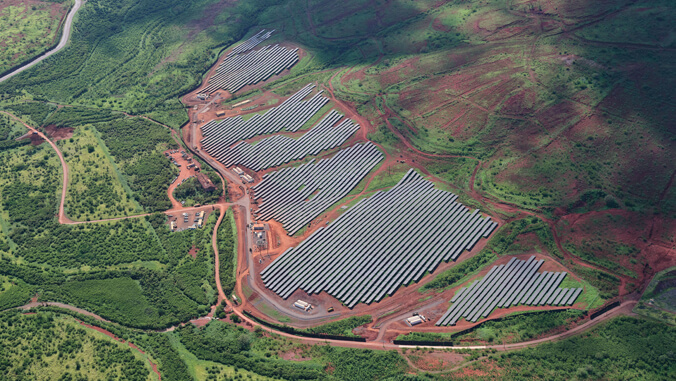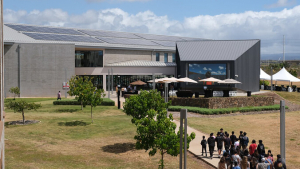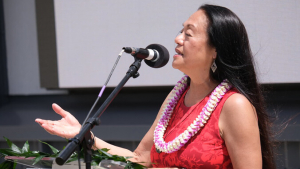
A blessing ceremony for a solar-plus-storage project located on approximately 66 acres of University of Hawaiʻi–West Oʻahu land was held in April 2024, but the work that made it a reality began nearly a decade earlier. That’s when a group of UH administrators started laying the foundation for the project that would help the 10-campus system meet its January 1, 2035 net-zero energy goal (producing as much as energy as consumed).

“I donʻt think people fully realize what it took to get to this point,” said UH Vice President for Administration (VPA) Jan Gouveia. “The moral of the story is that if you don’t start something now, you are not going to get something by 2035.”
The facility, built and operated by AES Hawaiʻi, is generating 12.5 megawatts of clean energy and is supported by a 50 megawatt hour battery energy storage system. It is operating under a 25-year power purchase agreement with Hawaiian Electric Co. (HECO) and is reducing fossil fuel use on Oʻahu by 750,000 barrels of oil.
Once upon a time, in 2015

HECO issued a Request For Information (RFI) for the project in 2015, a few months after Miles Topping was hired as the Director of Sustainability. Thatʻs when Topping brought the idea of using UH West Oʻahu lands for the project to Gouveia.
“Without Miles initially approaching us about this project, it never would have happened,” said Gouveia. “It then takes the staying power of key people over nine years to make something like this finally happen in 2024.”
The key people were Topping, Gouveia, VPA special assistant Carol Takahashi and UH attorney Bruce Matsui, who started meeting biweekly. Their early milestones included submitting UH lands to non binding HECO Land Request For Information, Board of Regent approval for Letter Of Intent (LOI) and Use and Occupancy (U&O) real estate agreement, and issuing the LOI and U&O to potential developers.
“The regents in 2018 really deserve a lot of credit for their willingness to venture a little outside of their comfort zone by approving a long-term agreement with an entity that was unknown at the time,” said Gouveia. “When you are trying to do something that has never been done before, you have to have the fortitude to do what it takes to make it happen.”
After AES Hawaiʻi was awarded the bid in 2018, Nick Molinari from the energy company was added to the UH team. They navigated through several legal and regulatory issues with multiple agencies and private landowners including the Board of Water Supply, Grace Pacific Quarry and local farmers.
Topping says negotiating this complex landscape was meticulous and required extensive collaboration with stakeholders, adding the UH team’s dedication and expertise was essential.
“Jan is responsible for so many things and for her to have the bandwidth to pay attention to this and breathe life into it was, I mean, it’s just remarkable,” said Topping.
Project embraces UH West Oʻahu values

At the April 2024 blessing ceremony for the new facility, UH West Oʻahu Chancellor Maenette Benham said the project is a perfect fit for the campus.
“The solar project embraces all of our institutional values of Poʻokela (educational excellence), Waiwai (philanthropy, scholarships and partnerships), Hana Lawelawe (service to the larger community), Kaiāulu (our campus community), and Mālama Honua (care of land, sea and sky),” said Benham. “We look forward to the continued benefits that it brings for our students, faculty, staff and their ʻohana (family).”
Along with generating and storing clean energy, the land is being used for sheep grazing. AES Hawaiʻi President Sandra Larsen said the solar-plus-storage project is focused on supporting Oʻahu’s economy and environment over the long term.
“It’s especially gratifying because the overall priority of this innovative clean energy project is to help make Oʻahu a better, healthier and more affordable place for future generations to make a life here for their families,” said Larsen.
A sentiment that everyone involved can take great pride in, especially the regents and the team of UH administrators who made it possible.

